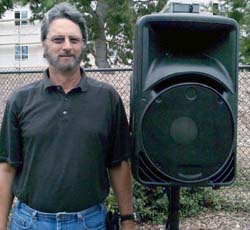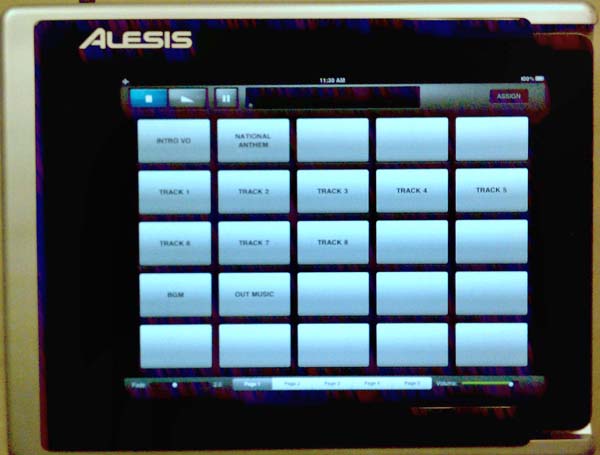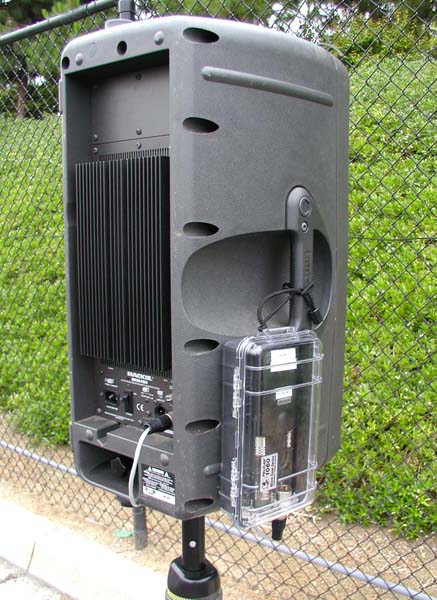
Mother Of Invention
Once Beach powered-up for the debut of the rig, the PSM700 receiver took readily to its new home inside the Pelican box. Two flush-mounted XLR connectors were added to the box.
The receiver’s antenna connector was also made easily accessible, and connected to a 25-foot long cable leading to a paddle antenna mounted atop an eight-foot tall boom stand.
The PSM700 receiver’s output left the Pelican box traveling in stereo on standard XLR mic cables to the loudspeakers. Later, Beach switched to mono mode to basically double the power and obtain a more stable signal. (Stereo isn’t a primary concern with this application anyway. And, all connections are balanced.)
From the receiver – which was held in place with velcro inside the Pelican box – a 1/8-inch TRS cable terminated with soldered connections at the flush-mounted XLR connectors. Beach built a cable with a Lemo connector on one end and a BNC connector on the other to run between the receiver and a flush-mount BNC connector mounted in the Pelican box chassis. A standard Shure antenna cable ran from the Pelican box out to the paddle antenna.
“When I first tested the system with Mike (Cromer), we just had a shorty antenna on the receiver like you’d use onstage,” Beach notes. “On the transmitter we had an 1/8th wave antenna. The system worked with those, so we figured performance would only get better with paddles at both ends, and it did – boosting our range to distances unbelievably beyond factory specs. The first time I used the system for a show, I set the receiver’s volume at about 75 percent.”
Control Central
Fast-forward to today, and we find that Beach’s wireless outdoor system has morphed and changed with the times, evolving to keep pace with the changing needs of the shows.
While in its earlier incarnations the system called upon a Denon DVD-2910 DVD player as the medium of choice for playing the soundtrack, delivering SMPTE for lighting effects, or a time code called FSK favored by pyrotechnicians, 2012 finds the rig subscribing to a design philosophy emphasizing as few moving parts as possible. Central to the control scheme these days in an iPad, which stores all elements of the soundtrack.
“All of my music files were rendered and edited in Sony Vegas Pro,” he adds, “then I created a playlist in iTunes for export to my iPad. Using one of two apps I downloaded, the files are assigned to touchscreen buttons providing me with the ability to load my show quickly, and change it just as fast on the fly if I have to. It’s a flexible, fast, and stable design—everything you want in other words.”
To better facilitate the use of the iPad – which is configured for left channel audio and right channel time code for the pyro – Beach chose an Alesis IO dock that provides pro audio quality output as well as charging capabilities for the little tablet computer. The apps in use on the iPad are LiveTrax and SoundCue. \

While both offer random access features and assignable icon-based control, LiveTrax also provides Beach with a linear approach to file management, within which he can view track lists as they play in sequential order.
Beyond the tracks, the system today has moved to a small-format Allen & Heath mixer, and added Shure PSM900 systems to its available inventory of IEM transmitters and receivers. “I’ve discovered that the 900 is a stronger component in terms of giving me higher audio fidelity and really decent range that exceeded any practical expectations I had,” he reports. “I can reach my receiver at distances of over 1,500 feet with obstructions all along my path and still maintain a good, strong signal.”
Never one to rest upon his laurels, Beach is looking for ways that the unconventional system can be taken to yet another level. “I’m looking forward to the day when I can actually send a digitally-encoded multi-channel audio signal out from the Alesis or some other type of iPad audio interface,” he says. “That way I can either get 5.1, or in more practical terms, just the ability to run stereo out to my main arrays at FOH and stereo out for channels three and four, which are traditionally reserved for rear surround and my delay…”
This type of creative thinking is a staple of his world. Onstage as a musician, the Southern Californian has played bass with the Mamas & the Papas, as well as a host of other 1960s pop rock icons such as Gary Puckett and the Union Gap, The Association, and Spanky and Our Gang. And offstage, it’s pretty obvious that he’s been endowed with similarly creative, albeit more technical, capabilities.
Gregory A. DeTogne is a writer and editor who has served the pro audio industry for the past 30 years.

